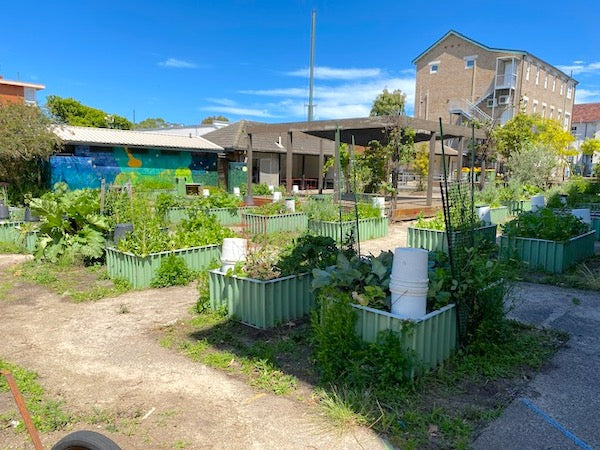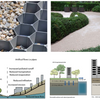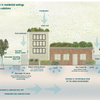WaterUps Sydney's Bondi Public School

This month we have been lucky enough to have a guest contributor. Fiona de Souza has been responsible for the kitchen garden at Bondi Public school. We asked her to write a piece about her experience with the introduction of wicking beds at the school. We thought that the Bondi Public case study would be of interest to other schools, and maybe help them with the building of their own school gardens.
Bondi Public kitchen garden
For the past three years, I have worked at Bondi Public School, maintaining the kitchen garden and running the education program there. For the last eleven years, Bondi Public School has run a successful kitchen garden program created specifically for schools by Stephanie Alexander. It is a great program that offers lots of advice and expertise to help students form positive food habits for life.
Bondi has a huge area dedicated to the garden. Originally there were twelve enormous, raised garden beds, very impressive, but as time wore on I realised that they were not as practical as a garden could be.

Firstly the antiquated watering system was a drip system set on a timer drawing water from the water tank. Some beds flooded, other beds received very little water. The beds needed constant watering, the pipes kept breaking and finally the water pump decided to give up. On top of that, the soil had to be replenished and fertilised due to soil seepage from the raised beds. I quickly came to the conclusion that it was time to find a beneficial long term solution, a solution that would be sustainable and easier to use in an educational situation.
Wicking beds
My research led me to wicking beds. Devised by Australian inventor Colin Austin, it seemed to be the perfect solution to saving water. I am a bit of a hands-on kind of gal so I was prepared to make them from scratch but thankfully I came across Ian Collins from WaterUps® which was lifesaving, to say the least.

I say life-saving as the system Ian has created is one of the simplest wicking solutions that I have come across in my research. As our old garden beds were falling apart and the watering system needing to be mended on a daily basis the wicking bed idea was welcomed with open arms.
Funding a school kitchen garden
I don’t think anybody really understood how beneficial the change to wicking beds was going to be. In fact, it sounded too perfect which raised a few eyebrows. Let’s just say those eyebrows are not raised anymore.
There are a lot of amazing grants to apply for. Firstly Waverley Council ($5000) was my first stop, and then the Sustainable Government ($15,000) and the Woolworths Landcare Grant ($1000). Our school also does a fair bit of fundraising and contributed ($3000) towards the project.
Of the $15,000 of the Sustainable Schools Grant a fair chunk of that went towards the installation of six water pumps for not only the school garden but also for multiple unused school tanks. I believe it is important that if we are going to teach students about sustainability it is important to have our schools established as sustainably as possible. Water-saving is one of the most important to me.

I believe that recognition for a garden project is so important. It has such a long-lasting impact on a school community. In my three years of teaching garden I have learnt a lot. What a garden can teach is incredibly far-reaching, accessing students on all levels and especially inclusive of students with additional needs. I found funding bodies to be very receptive to the wicking garden in our school as it is one of the best ways to have hands-on education and practices sustainability long term.
Benefits of wicking beds in schools
For approximately $12,000 I managed to put in place 35 WaterUps® 1600mm x 800mm Oasis wicking beds for our school. In 2020 we have 588 students and the garden is well utilised. It is something that could not have happened without the expertise and help from Ian. The watering system is now simplified as the wicking beds only need to be filled approximately once every three weeks. This is so helpful in a schooling system with holidays and long periods of time with the garden unattended,

In each of our beds, we also established a worm tower that takes food waste which feeds the worms and creates compost which feeds the soil. This stops the need for external fertilisers. The soil is constantly improving as one of the benefits of the wicking bed is creating a mini ecology of beneficial biology of the soil. This comes down to moisture in the soil which the wicking bed supports.
The wicking bed is also a water saving device. Rainwater is captured by the bed thus further reducing the need to water on a regular basis. The old raised beds lost both water and soil on a regular basis which was a constant loss.
No looking back for our wicking bed
Our wicking bed garden project was completed in April 2020. A new, and flourishing garden has been established. The WaterUps® Oasis beds are a perfect size for students of all ages to work on. I am beyond happy with how easy they were to establish and to maintain.









